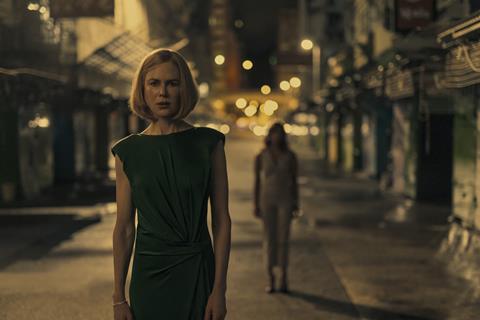
In exploring the lives of three US expat women living in Hong Kong in 2014, Amazon Prime Video’s drama Expats takes place against the backdrop of some of the city’s most recognisable locations. Exteriors unfold within the night market and in the HSBC building overpass where scores of domestic workers gather for picnics every Sunday, while interiors encompass luxury penthouses and working- class flats.
Director Lulu Wang worked with US-based production designer Yong Ok Lee to painstakingly recreate the city as it was a decade ago. While they always knew they would have to recreate the city when shooting in studios, what came as a surprise was having to recreate 2014 Hong Kong in Hong Kong itself.
Lee went to the port nation in July 2021 to location scout and begin her research. “Hong Kong is a character in the show,” she says. “For me, [being there] was to see the uniqueness. Their British history, and also their Cantonese history. It’s in the details, they tell you where you are.”
With Wang and cinematographer Anna Franquesa-Solano, Lee had to quarantine for several weeks in a hotel room on arrival in Hong Kong. It proved a creatively fruitful time as they watched reference movies including Magnolia, Nashville and The Long Goodbye in their separate rooms, discussing them in detail on the phone.
When they started location scouting, they looked for spaces that spoke to the tone they wanted to achieve. Lee was then challenged to make sure those spaces and builds were authentic to the 2014 time period.
The production’s initial plan had been to film location shots in Hong Kong, and then move to a studio in Malaysia for the majority of the interiors.
But the ongoing challenges of the pandemic caused the Malaysia plans to fall through and the team decided on Los Angeles for the interior studio builds.
Filming took place in Hong Kong, along with some on location set builds, during the summer and early autumn of 2021. In November 2021, Lee and her team moved to California, to begin work at Santa Clarita’s Los Angeles North Studio.
Door hinge details
The team intended to return to Hong Kong in February 2022 for reshoots but when it came clear that ongoing Covid restrictions in Hong Kong would make this impossible, Lee was tasked with recreating almost every Hong Kong location in Los Angeles.
“I didn’t expect to build this much,” Lee laughs. There was, however, a silver lining to the pause in production: it allowed time for improving, and importing. “[Door] hinges are completely different [in Hong Kong] than the US,” notes Lee. “When we built the apartments [in Los Angeles], my art director brought hinges from Hong Kong. I wanted to make sure we matched the hardware.”

The night market was a particular challenge for Lee. Scenes in the Night Market were shot both on-location in Hong Kong and as a build in Los Angeles.
For the on-location shoot, since the city has changed drastically since 2014, “We had to dress the entire block when we shot in Hong Kong. From our research we knew all the signage had been taken down. We had to create a lot of the signage for the wide shot.”
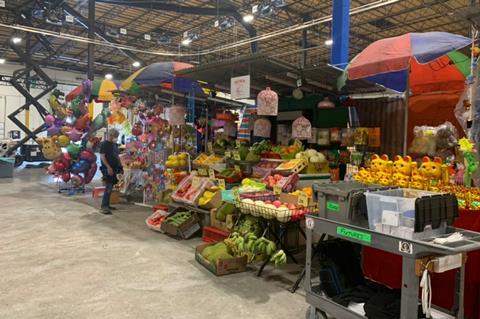
When filming of these scenes moved to Los Angeles, Lee and her team had to build Hong Kong-style vendor booths for the replica market. This was, says Lee, the most difficult task, as the Los Angeles-based construction crews had never assembled anything like this before:
“It’s very unique to Hong Kong vendors,” says Lee.
Luckily, art director Haley Ho found an instruction manual for the booths — the only issue was they were entirely in Chinese. “Hayley is Taiwanese and speaks Chinese so she translated it into English for the crew and set designer.”
Another big issue was sourcing what Lee calls “continuity props”; specifically, in the pivotal night market scene there is a toy vendor with cars and balls. “All of that stuff was already featured in [the shoot in] Hong Kong. And then we needed to make sure we had exactly the same [in Los Angeles].” Lee had the toys shipped over.
Some elements could not be identical or even sourced from abroad, due to time and budget constraints, such as the marble surfaces in the luxury apartments and tiles in the homes of the regular Hong Kongese. The latter were their own design challenge, because the tiles are scarce. They made replica after replica of the unique mosaic tile rather than try to source them.
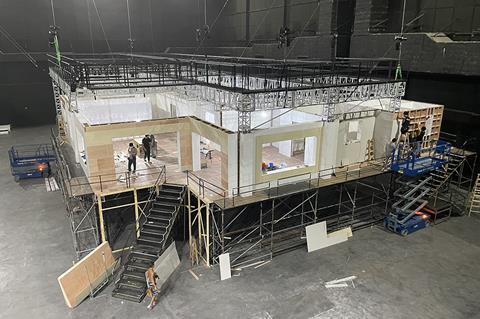
For the luxury apartments built on set in Los Angeles, Lee relied on her research to create authenticity. “When we went location scouting, we saw so many luxury apartments and they were all built in this way: The immigrant workers’ room, almost like a cell, was within the apartment,” she explains.
Lee decided to build the luxury apartments in this style, rather than build a separate set for the domestic worker’s accommodation.
The rooms of the domestic staff more closely mimicked those of the regular people: packed with necessities rather than luxuries, and cramped. The challenge this posed for Lee was in sourcing Hong Kong specific domestic items with which to fill the space.
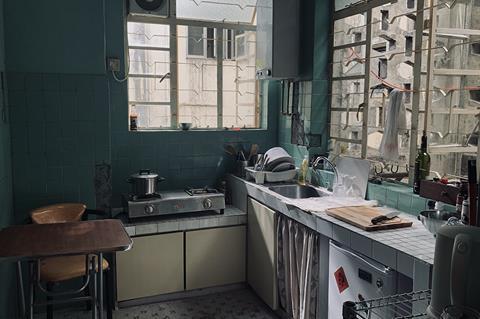
One home that did not need to be recreated in Los Angeles was that which belongs to the character of Mercy, played by Yoo Ji-Young. This was an on-location shoot in an empty building in Hong Kong, and is one of Lee’s favourites, inspired by the romanticism of the films of War Kong Wai.
“When I designed it, I [imagined] the landlord divided one space into three or four apartments, which is very common in Hong Kong, so I wanted to show that funny layout instead of a typical layout.”
Lee built walls, added fake doors, and with the help of cinematographer Anna Franquesa-Solano used camera trickery to make it feel smaller and stranger than it was.
While shooting on location in 2021 Hong Kong, Lee cites signage as the biggest challenge in recreating 2014 Hong Kong. After a location was chosen, Lee had her team gather as many photos of that area from 2014 as possible. Then, they figured out what design changes they could make in order to transport Hong Kong back in time.
“For example, we had a shoot in a McDonald’s. However, nowadays McDonald’s signage is different – the colour scheme, as well as the kiosks. We changed the logo, the colour, and we covered all the kiosks to recreate a 2014’s accurate McDonald’s. It’s still modern, but it’s obviously very different [to today].
“We all wanted to make sure that we were showing the Hong Kong of 2014 the right way — because we’ll never see it again.”






![The Brightest SunScreen[Courtesy HKIFF]](https://d1nslcd7m2225b.cloudfront.net/Pictures/274x183/3/5/0/1448350_thebrightestsunscreencourtesyhkiff_312678.jpg)




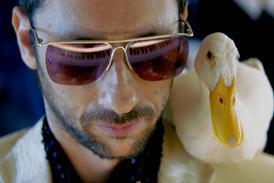













No comments yet